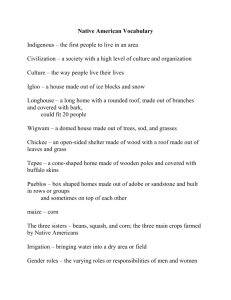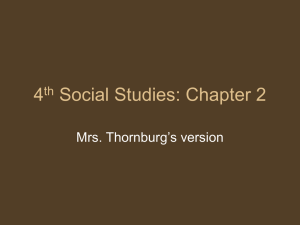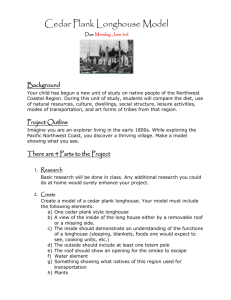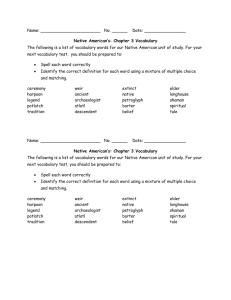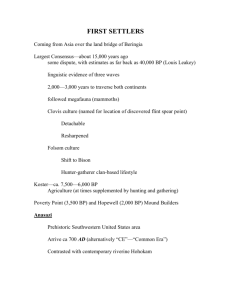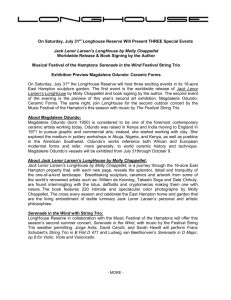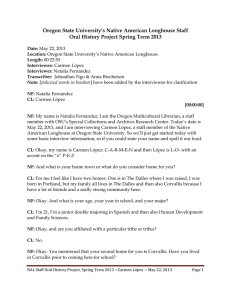Oregon State University’s Native American Longhouse Staff
advertisement
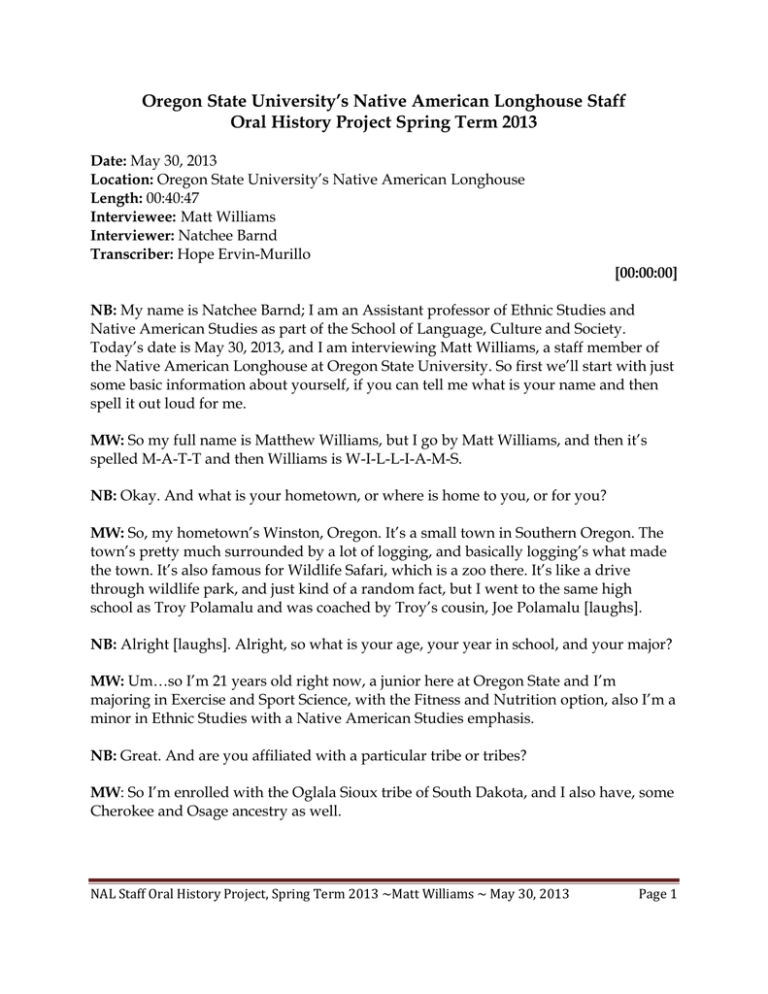
Oregon State University’s Native American Longhouse Staff Oral History Project Spring Term 2013 Date: May 30, 2013 Location: Oregon State University’s Native American Longhouse Length: 00:40:47 Interviewee: Matt Williams Interviewer: Natchee Barnd Transcriber: Hope Ervin-Murillo [00:00:00] NB: My name is Natchee Barnd; I am an Assistant professor of Ethnic Studies and Native American Studies as part of the School of Language, Culture and Society. Today’s date is May 30, 2013, and I am interviewing Matt Williams, a staff member of the Native American Longhouse at Oregon State University. So first we’ll start with just some basic information about yourself, if you can tell me what is your name and then spell it out loud for me. MW: So my full name is Matthew Williams, but I go by Matt Williams, and then it’s spelled M-A-T-T and then Williams is W-I-L-L-I-A-M-S. NB: Okay. And what is your hometown, or where is home to you, or for you? MW: So, my hometown’s Winston, Oregon. It’s a small town in Southern Oregon. The town’s pretty much surrounded by a lot of logging, and basically logging’s what made the town. It’s also famous for Wildlife Safari, which is a zoo there. It’s like a drive through wildlife park, and just kind of a random fact, but I went to the same high school as Troy Polamalu and was coached by Troy’s cousin, Joe Polamalu [laughs]. NB: Alright [laughs]. Alright, so what is your age, your year in school, and your major? MW: Um…so I’m 21 years old right now, a junior here at Oregon State and I’m majoring in Exercise and Sport Science, with the Fitness and Nutrition option, also I’m a minor in Ethnic Studies with a Native American Studies emphasis. NB: Great. And are you affiliated with a particular tribe or tribes? MW: So I’m enrolled with the Oglala Sioux tribe of South Dakota, and I also have, some Cherokee and Osage ancestry as well. NAL Staff Oral History Project, Spring Term 2013 ~Matt Williams ~ May 30, 2013 Page 1 NB: Great, thanks. Alright, so the next series of questions are about your work here at the Longhouse. So, first question is what is your position at the Longhouse and what do you do or what does that entail, and then, sort of a follow up, and how many years have you worked for the Longhouse? MW: Uh, so currently I’m Internal Coordinator here at the Longhouse, one of two coordinators, internal being a person who takes care of stuff within the center, paperwork, purchase requests, uh, meets with the office assistants and assigns tasks to them. The External Coordinator deals with more of the outside things with the community and with other centers on campus, um, so I’m pretty much a person who’s in charge of maintaining, the center—make sure, you know, we have things, like supplies stocked up, paper and supplies for students coming in. A lot of what I do, I create the staff meeting agendas and help facilitate the staff meetings and, just make sure the OAs and some of the support staff are on task and basically be a person, that can provide support to groups coming in and information to them, as well. NB: And how many years have you worked for the Longhouse? MW: So this is my third year working at the Longhouse; this year’s my first year as an internal, uh last year I was Activities coordinator and freshman year I was an Office Assistant. So I’ve kind of went up the ladder in that aspect, and moved my way up. NB: Okay. So it sounds like you didn’t have any other space, but I’ll ask the question anyway. Have you worked for any of the other cultural centers? MW: [Laughs] No, I haven’t worked for the other centers, um, I’ve considered working for another center just to get new experiences, and working with a different community, but even by working here at the Longhouse, we work with all centers anyways, and we have meetings - the all coordinator meetings we have with all the other coordinators at every other center - and so we do a lot of work around, some collaborative events with other centers as well. So we do get a lot of experiences with working with them, as well. NB: Okay, that question will come up again, so we may add to that later, but when did you, or why did you decide to work at the Longhouse? MW: So, when I came here as a freshmen, I really had no clue there was a Longhouse, until someone, one of my friends mentioned to me that—he knew I was, I identify as Native, and he’s like, “Hey, you know, the Native American Longhouse is hiring,” so I went over and applied and I got the job as the office assistant, and basically, you know, I really had no intention of working there, honestly, it’s just I needed a job at the time, but I’m really glad I did, because of all the experiences that came about. So… NAL Staff Oral History Project, Spring Term 2013 ~Matt Williams ~ May 30, 2013 Page 2 NB: Mhmm. Thanks to that friend, right, that told you about it? [laughs]. So, do you think that your expectations—although you said you were—you know, you didn’t even think you were going to necessarily get the job or work there, but, and I’m saying there because we’re sort of looking at that old site, which is no longer there, but, um…whatever expectations or hopes that you had for the work, and maybe not, maybe the first year, but maybe the second and the third years, do you feel like those hopes or expectations for your work were either matched or not matched or were they surpassed, and maybe a little bit about why you felt like they sort of matched your expectations or hopes for the positions? [00:05:32] MW: Um, I think for the most part they matched. I think they’ve exceeded some of my expectations with some of the events that went on, and just planning and giving me experiences personally, and growing from it. I think it matched in the respect that it wasn’t something I wasn’t expecting. I—I expected pretty much everything I experienced, and you know, I—it wasn’t too much of a workload or anything. It was just about right. You know, it’s really nice that they, a lot of jobs on campus, especially the cultural centers, work around your class schedules, and work around, you know, as being student-led, student-run centers; I like that aspect of it, is that they work around your schedules, and you know, whatever responsibilities that you have with other groups on campus. I’d say they meet for the most part, and in some ways exceeded. So… NB: Okay. So I’m going to split this second, this next question in actually into two parts. So first part is can you describe the projects, events or activities during the Fall Term, or specifically during Heritage Month, that were especially meaningful to you? MW: So for Heritage Month one event that was important to me was actually an event that I put on, which was acorn processing. And I did that event with Margaret Mathewson, through the Anthropology Department, and she basically came in and we worked on doing uh grinding of acorns and I thought it was like really culturally significant, ‘cause a lot of people would come in and learn the significance of, you know, what acorns were used for as staples of diet, especially, you know, tribes in Northern California, used them a lot. And, I—I just thought events like that are really important to me because you know, teaches people traditional ways, traditional lifestyles and also, you know, modern day like people can still use acorns if they know what they’re doing [laughs]. And so I really like that and using natural things from the land and um…Let’s see, another event I thought [phone rings] was really good was um…here we go, I have to [phone rings] stop trying…So the other event that I really liked was actually the end of Heritage Month and it was the indigenous feast which was NAL Staff Oral History Project, Spring Term 2013 ~Matt Williams ~ May 30, 2013 Page 3 held at a dining hall here on campus and basically that consisted of, there was chefs that came in and did traditional meals from different regions. I believe we had some dishes from the Northeast, from the Southwest, we’ve had the some dishes from the Southeast even, and Northwest, you know, salmon being a stable to Northwest tribes diet. And I just thought that was really cool how there’s foods from each region of the U.S. represented there and it taught people about the kinds of traditional diets and what, you know, the things people ate to live on during, you know, when tribes lived off the land and everything, and I just think it’s important that people, you know, experience that because it’s, you know, part of the U.S. history, and the first peoples that were here. NB: Okay. So the second part of this question then is can you then describe the projects, events, or activities during the Winter or Spring Term that were especially meaningful for you? MW: Um, so for the Winter Term we didn’t have a whole lot of events. That’s usually our, um…our term where we’re kind of preparing for the Spring term events, and we have a lot of downtime, but Spring Term, the two events that were really significant to myself and to our staff was the Salmon Bake and also a Pow Wow, which was put on by the NASA, Native American Student Association. The Salmon Bake, you know, is just really important. It’s our biggest event every year. This year we’ve had well over a thousand attendees, as well, you know, as having the family come over from the Warm Springs Reservation. They come every year and do a great job and this year we had a drum group and a dance group and it’s just, it’s something people look forward to every year. And we want to do a good job of putting that on, representing not only our center but our community around OSU as well. NB: And what, so what’s the, whose the family that comes out from Warm Springs? MW: The family that comes from Warm Springs is the Jacksons, Kate Jackson is the grandma and she comes and she’s pretty much the head of it all, and then she brings some family members; I know Sheila is the mom, and then…I forget the name of the son, but he comes every year and helps, and her friend Richard, who works for the Environmental Resources office at Warm Springs, he comes and helps cook as well. So they’re—they’re the same people that come every year and they’re really supportive of Oregon State and the Longhouse in general. [00:10:46] NB: Okay. Alright. So next question, what have been your challenges working at the Longhouse and…how have you overcome them, whatever they may be? NAL Staff Oral History Project, Spring Term 2013 ~Matt Williams ~ May 30, 2013 Page 4 MW: I’d say some of the challenges that I’ve faced here is just trying to manage time for the most part, because it is hard being a student and working at a student-run, studentled center where expectations are higher. And you have people coming in, especially with our new center, we have people coming in all the time, and you have to be just prepared and you know, kind of on spot, just to, you know, for people asking questions or they want to tour and it’s just, it’s just managing time has been a little bit hard for me. I know freshmen year I was on academic warning for one term, and so but Diversity Development and Victoria Nguyen was very good with uh working with students, you know, emphasizing academics first, and she put me with an academic coach freshman year to get my grades up for the next term, and I think that was a good learning experience for me, that term, just, you know, how to manage time, to focus on school, and you know, I was a freshman trying to, you know, find out where I stood in college, and trying to find where I fit in here at Oregon State, and you know, I felt like the Longhouse was a good fit. And then one other challenge is just kind of trying to put school first, ‘cause sometimes you want—might want to put the Longhouse work first, ‘cause you really enjoy it or I really like being here and stuff, and, but you know, school’s the first, should come first, is really important, and that’s kind of one challenge is basically just the time management and everything. NB: Alright. Great. So what have you, or what would you say are some of your successes working at the Longhouse, and this can be personal, it can be sort of programmatic, or otherwise. MW: Um, I’d say a lot of my successes, a lot of mine personally came last year when I was Activities Coordinator, because I put on activities—coordinators are required to put on two events per term, that’s six per year. And when I was activities I put on, the acorn processing which is kind of an annual thing we do every year, and also we had a storytelling event, which was really good. A lot of people from other cultural centers came to that as well. And it was Gordon Bettles, he’s a storyteller, an elder from the Longhouse in U of O in Eugene, and he’s really good and that—that event was important to me, you know. I’d see those two events as accomplishments on my part, especially the acorn processing that we do it every year now, and we have good relations with the Anthro department and for future events, we’ve had discussions about, you know, doing like an outdoor space outside of this center and maybe doing like brain tanning and things like that, you know, a little more messy but traditional things, you know, that are really cool. So I believe that, that’s a big accomplishment on my part, just getting that started with the Anthro department and those relations, so… NB: Great…so what—and you mentioned this earlier, but um, as of—to return to it, what have you been here—what have been your interactions with staff from the other cultural centers? NAL Staff Oral History Project, Spring Term 2013 ~Matt Williams ~ May 30, 2013 Page 5 MW: Um…so freshman year I didn’t have a whole lot of interaction with the staff, just being an Office Assistant. Really the only reason I would go to the other centers is if they sent me on an errand or something, to run flyers or things like that [laughs]. You know, being a new guy they kind of send you on the jobs no one wants to do, so… NB: [laughs] MW: that was my really only interaction with the other staff, and I didn’t know half the staff in the other centers when I was a freshman, but the last couple of years, being Activities Coordinator and doing events, I’ve had a collaborative event with the Black Cultural center, so I had to work a lot with some of the staff there, and I knew a few of the staff, from freshmen year there as well, but I did an event with them, uh, centering around African American/Native American relations, like especially in the South. [00:15:09] Um, like during the Civil War era, and we had Dr. Robert Thompson come in and speak from Ethnic Studies, on some of those relations and relations, you know, I wasn’t even that much aware of until, you know, that event and then a lot of people, you know, discussed some of those historical relations between tribes and African Americans. So that—that was one way I worked with the other centers, was doing some of those collaborate events. This year I’d say more—I know most of the staff at all of the centers [laughs] this year, so it’s more I see them at the events that all centers attend, or like, you know, Salmon Bake a lot of the other centers were there, their staff. So some of the bigger events on campus, you know, like the step show they just had last weekend. I saw a lot of staff from other centers, so, usually at these bigger events is when we get to meet with them and also at the all coordinator meetings we meet with a lot of the other staff, as well. NB: Mhmm. Okay. And so, I—actually it’s a follow up, so on the…um, the…black and native sort of…event, was that, how was that initiated? Was that initiated through the cultural center staff, or… MW: That was—yeah, that was initiated through the staff; that was actually me and uh, Yohana Abraham, she activities last year for the Black Cultural Center, we just wanted to work together ‘cause we needed another event ‘cause we were required to do two each per term, and that counted as one, even though we collaborated. And she just wanted to, you know, what are some ways we can collaborate and do a historical event between the native Longhouse and the Black Cultural Center, and that was one way, because Dr. Thompson was knowledgeable on some of the race relations during the time, so we just had that talk and Yohanna I’ve known since I came here to OSU; I was NAL Staff Oral History Project, Spring Term 2013 ~Matt Williams ~ May 30, 2013 Page 6 in a bridge program, prior to um, Fall Term starting freshman year. It was basically like we took a course, transition to college and we went on a rafting trip and it was a really fun experience, just getting that tra—er transition to college, and that’s where I met her and so kind of she was a person I met since, I mean, ever since I’ve been here, so we wanted to work together on an event, so… NB: That’s great…Cool, alright so I have two questions just about the new Longhouse. So first one is just were you a part of the design process for the new Longhouse, especially since you’ve been here for several years, and if so, just, a little bit about how what—how, what, how you participated in that. MW: Yeah, so wasn’t…too involved with the actual design of the structure of the building. I was more involved with the placement of some of the items, the totem pole, the, some of the furniture, the television, things within this center, myself, Tyler Hogan and Daniel Cárdenas were involved with making those decisions and you know I felt like that was, I’m glad Victoria asked us that because, you know, we can have our input as to where those items are placed. And also some of the, some of the doorways we were kind of discussing, you know, where would those go, but we weren’t involved too much with the whole structure, outside, you know, frame design of the center. NB: Okay. And then sort of a more of a reflective question here is, you know, what, you know, we have just transitioned right, and so what would you say the new Longhouse means to you? MW: So…to me, you know, this new Longhouse has been, a long time coming, in my opinion. To me it means a lot because, it’s one of the newer structures on campus, even though there’s a lot of construction going on right now; it is something that people see, um, you know, just walking by going to Dickson, they’re just like, you know, “Wow, that’s—that’s a great center” - you know, just kind of mind-blown by how, how beautiful it is and everything, and when people come in, you know, it’s great to hear things like, “Oh this is—I’ve never seen a Longhouse like this” and there really isn’t too many cultural centers on college campuses, so, to me it’s really special that, you know, I’m fortunate to be here at Oregon State where they’re really inclusive of diverse communities and they’re making this possible for all the cultural centers. Not just ours, but as rebuilding them and as brand new cultural centers, so… NB: Great. Uh, so the next, series of questions are just about the future and the larger picture of the Longhouse and, you know, the future of the Longhouse. So first is what projects, events, activities, etcetera, would you have liked to have seen, or would you recommend for the future? Some things you thought about would be great. It sounds like you did initiate several but are there are others that you still kind of think it would be really great if someone in the future could do this? NAL Staff Oral History Project, Spring Term 2013 ~Matt Williams ~ May 30, 2013 Page 7 [00:20:09] MW: Right. Um, there are a few things like I mentioned with the, with Anthro doing some of the outdoor, you know, things, like brain tanning, I think that’d be great to do more of those events. Also one event that Mariah Huhndorf, our activities, was trying to do for a while but never really got a lot of support for doing it, was an Alaskan Native Games, and basically now we have the space to do that kind of thing. It would be great if we could maybe collaborate even with Dickson Rec and, or do it there or something, which, you know, we’d have like a full basketball court to do it, and maybe work with uh Greek Life on doing something, ‘cause I know Greek Life is like not as involved with the cultural centers, and I feel like there should be some sort of tie as like to cultural awareness within those communities, ‘cause there is not a lot with the Greek community. But just having something fun and open for people like that, maybe they can, the Greek communities can sponsor t-shirts or something for the event as they’re really good at doing those sort of things, like fundraisers. Just having something like that would be really good, I think, in my opinion, just to, you know, have an open, fun event, and that way, you know, Greek life will learn a little bit about, you know, the cultural centers and the Native American Longhouse in specific. A few, one other thing I really think that’s lacking is, myself and Tyler and Daniel had discussions about is actually going out to visit high schoolers from Native tribes in Oregon. Maybe doing, you know, every term doing a trip to a different reservation, or a different, tribal community in Oregon and just talking to, you know, high school juniors and seniors about coming to college, and where the resources that OSU provides for Native students, and ‘cause I feel that’s really important, especially with Native student retention being not very good at most universities and even here. You know, things like the Longhouse is a great opportunity for a lot of students to you know, to have support and feel like that second home, you know. NB: Mhmm…Alright, so what advice would you give future Longhouse staff, or just generally any OSU cultural center staff, from your experience, you know, you’ve had several years at least, so you’ve seen a lot of things [laughs]. MW: [laughs] I feel like one of the best pieces of advice I can give to someone working here or at any cultural center is just to, if you’re coordinator, its best to delegate tasks, because then, I know, beginning of this year, a couple times I wouldn’t delegate things and then everything would be on me to get done. So I wasn’t as good at doing that as I should have been, but use your office assistants if you’re coordinator, make sure they’re they have tasks assigned, things to do, and also just, just working as a group, especially on the bigger events, because it’s hard when maybe two or three of the coordinators are doing a lot of the bulk of the work and then the office assistants and other support staff NAL Staff Oral History Project, Spring Term 2013 ~Matt Williams ~ May 30, 2013 Page 8 are, you know, just doing small assignments. It’s good to work together and, especially when the big events come, to execute them, you know, it’s easier with the full staff on board working, so… NB: Sounds like it’s probably beneficial for them as well, right? Possibly preparing them for a transition to get other positions, and… MW: Yeah, and that, that actually, you know, after this year a few of our office assistants considered applying for activities coordinators next year. So that’s just something that helps them prepare, and even office assistants, if they wanted to put on an event together, that’d be a great experience for them, you know, actually doing an event and maybe, maybe having to, you know, talk in front of people or something they’re not used to doing, so it really prepares, you know, students for getting those experiences and moving up, so. NB: Yeah. Okay. So based on working at the Longhouse, what is a take-away that you’ve gained, that you would like to share with others, so other than sort of the advice, but what take-away do you think you’ve…you would bring with you when you leave, so thinking about what, you know, I mean once you’re gone, you’re graduated, you’re out in the world, what is that thing that you, that you’ve gained that you’re going to take away, you think? MW: One thing uh, personally I think I’ve gained is just, one thing is maturity. I think I’ve matured a little bit since coming here freshmen year. And just learning to be more responsible, you know, working with a staff. You have to work with a group, so that can apply to any job that you get in the future. You know, having someone ahead of you, like Daniel’s ahead of me, so. You know, respecting authority and just, just general things really, working with a group, learning to you know, make deadlines; pretty much anything we do here is maybe not to, like, an extreme like, you know office, like business job or something, but it does prepare you just for things like that in the future. Whatever your job might be, whether it’s, you know, you’re going to be a P.E. teacher, or you know, working with uh, as a CEO of Nike or something [laughs] it really applies like, in any way, so… [00:25:32] NB: Those skills right? Those skills that you need. Um…so what is the biggest issue for you in terms of the purpose of the Longhouse and why do you think that is an important issue? NAL Staff Oral History Project, Spring Term 2013 ~Matt Williams ~ May 30, 2013 Page 9 MW: I think one of the biggest things, one of the biggest misconceptions that students have when they come in here is that “Oh, do you have to be Native to come in here? Is it just for Native Americans?” And, we’re trying to, you know, get this out to the community here at OSU that, you know, it’s not just for Native Americans, it’s for, you know, we’re here to support the Native community as well as the non-native community, and any students that come in here, and you know, we’ve had students come in and show us their tribal enrollment cards… NB: [laughs] MW: and it’s like “you don’t have to do that, you know? Really, just, it’s fine, anyone can come in here, it’s open to anyone.” And I don’t know who puts these things in people’s minds, but it’s just, we’re trying to, you know, make our presence on campus and you know, it’s kind of been an issue because, I mean, sometimes we have the same students that are coming in here and a good majority of them do identify as Native American, which is good you know, we’re supporting Native students, but there’s still some here that, you know, just don’t come by or choose not to be here, but just getting our presence felt on campus, that we are supportive of some of these other Native students here, as well as non-native, so… NB: Mhmm. Okay…uh so how would you describe the impact of the Longhouse on Native students? And you’ve sort of already started to answer that, but… MW: Yeah, so I noticed the transition from our old center to our new center. We had some new students that were transfer students here that started coming regularly and they started showing up and I noticed they’re—they kind of stuck around, and there’s a few of them that have considered even applying here next year for a job, so for the most part, you know, I think we’re doing a pretty good job, and now that we have the events like the Grand Opening and we had a lot of Native alumni, and a few students here, you know, that were there and they were like, “Oh man, this place is cool, and, I’ll start coming by more,” so. And our NASA group, you know, has gotten bigger, with the Native American Student Association putting on the Pow Wow this year, so I feel like um, for the most part we got a pretty decent start, but I’d like to see the numbers go a little higher in the future, so… NB: Mhmm. Okay. So parallel to that, how would you describe the impact of the Longhouse on OSU and the local community more broadly? MW: Um…on OSU, it’s a positive impact for the most part. Now that you know, all these changes with Oregon State, and Oregon State being you know, one of the, I consider one of the top institutions in the country to go to college, especially you know, NAL Staff Oral History Project, Spring Term 2013 ~Matt Williams ~ May 30, 2013 Page 10 like engineering, agriculture, really popular programs, forestry, and more of a really science based college. I just think it says a lot about how inclusive a university is when they’re, you know, putting this much effort out to rebuild cultural centers. It says a lot and it says a lot about how supportive Oregon State is of the Native community here and the surrounding tribes you know, with Grand Ronde and Siletz being right over here towards the coast, you know it’s really supportive to them, they see that and they’re like you know, OSU’s supportive of us as being Native people. Even though not—Corvallis is not necessarily the most diverse, especially in regards to Native American population, but just in the surrounded area, with the surrounding tribes, I think it says a lot, so… NB: Okay. Uh, so what suggestions or ideas do you have for future collaboration between the Longhouse and with OSU or with the larger communities, so ideas of an event you may have or how the Longhouse might collaborate, differently than maybe they are already? MW: Um, I feel like with the University in general, uh, we haven’t really done a whole lot um, that I know of. You know, Daniel or Tyler might speak better on this, but I really haven’t seen like a lot between, you know, the OSU…like, I don’t know, just in general the OSU community and the Longhouse. [00:30:07] I have seen, you know, things like the Grand Opening, I know President Ed Ray and Larry Roper have shown their support, but I’d like to see more from some of the departments and colleges focusing more with us. I know there’s a couple groups that have reached out and that’s a good start. Student Health Services is one that’s reached out to us a lot and really wants to collaborate. They actually met with all the centers and, or really wanted to focus on health related issues within each community and I really thought that was a great idea, you know, just for that awareness, you know they focus with us on, you know, diabetes, and things like that, and they’re just, you know, they came and talked to our staff and were just like, “Hey what are some things we can collaborate with on in the future in regards to you know, promoting health awareness here at OSU?” And I felt like that was a good start and a good initiative for them, and I was glad to see them, you know, put their head forward and kind of you know, get out there and meet with us, ‘cause there’s very few groups have done that. I know the Center for Civic Engagement has met with us and, you know, I’ll be attending the trip to Warm Springs after this term, for a week, doing community service, and I feel like that was a good outreach program with them, you know, just you know, student sustainability has reached out to us. So there’s been a few groups that have really wanted to work with us; I feel like there needs to be more like, involvement with like NAL Staff Oral History Project, Spring Term 2013 ~Matt Williams ~ May 30, 2013 Page 11 the College of Public Health and Human Sciences, the you know and now Ethnic studies is being involved, so, there are groups, I just want, like, to see more departments getting involved with us. NB: It sounds like you also—you’re suggesting that it does require them to take some initiative to sort of make those links, ‘cause… MW: Yeah NB: ‘cause you all are fairly limited MW: right NB: in terms of how much you can do outside, but it sounds like you’re appreciative when they make that effort to bring in and say, “Look we’re thinking about you, we want you, we want you, we want to be in, you know, have a partnership with you in some way” MW: Right and they do have to take that initiate, we’ve also had uh, Susan Flores from the OSU Alumni Association, she’s been super supportive of us, and she kind of came out of nowhere. No one knew who she was before, and now— NB: --I think she’s, I think she’s new, so that’s partly what it is too [laughs] MW: Okay [laughs], but she’s taken a really big initiative in working with us and I’m glad she is, you know, working with these alumni groups, Native alumni and things like that’s really helpful to the center and helpful to us as a staff. So yeah, I mean, I feel like these groups needed to take initiative for the most part, and to help us, you know, collaborate with us. NB: Yeah. I know personally I also met a lot of the alumni just this last event from the Grand Opening and then alumni event that followed that evening, and I was able to meet a lot of Native alumni, many of them had worked in the Longhouse in previous years, so that was already could see the impact of that kind of initiative. Um…last uh, question in this future and larger picture section here, can you describe your thoughts on why sharing your stories, or these kinds of stories, is important to you and to your identity? MW: You know, I could probably talk a long time on this, but just sharing a person’s experiences in general and their history or where they come from is just helpful to the future of the Longhouse, to their staff, you know, cause they can go back and listen to NAL Staff Oral History Project, Spring Term 2013 ~Matt Williams ~ May 30, 2013 Page 12 these and you know, take advice from it and learn you know, where has this center been, how far has it come? you know we’ve, we’ve been at the old Longhouse since 1971, so that’s, so that’s a long time you know, to wait for a new center and now we have all this going on and we’ve had, you know, high school groups coming through now from reservations and from other tribes in Oregon and that’s something we really like to see because those groups are seeing that, you know, there’s a place for native students and moving forward just the oral tradition, you know, talking about like where we come from is good, you know, students can kind of see “Oh maybe they’re from the same tribal community or something” or from the same area, you know. My my dad being adopted from Pine Ridge, when—Pine Ridge Reservation, South Dakota, when he was a year old was, was pretty you know, devastating to him actually, as a person, ‘cause he didn’t know a lot about his tribal heritage growing up, and when he got older he had to kind of relearn you know, like where he came from. He went and worked at an alcohol rehabilitation center for five years and they put on a Pow Wow every year, and he would, he would help do that in California where he was living at the time and he learned a lot about his culture that away. You know, just things like that, learning where people come from, that’s where my whole native family is from, Pine Ridge and so you know, it’s just interesting to hear stories about where people come from, you know, some of their experiences. I heard stories form my dad and great uncle when he grew up on Pine Ridge and you know all the crazy things that were happening during AIM and 1970s back there. You know, I just think for the most part it’s really cool to hear other people’s stories, I like listening to them, so. [00:35:42] NB: So there’s one question just about campus sort of experience, can you describe your experiences at OSU pertaining to your racial or ethnic identity and/or your tribal affiliation, so just generally what had it been like and what is your experience as a Native person walking around campus? MW: [laughs] NB: Being at OSU, like, how would you describe that? MW: You know, it’s interesting because I noticed when I first came here, you know, working at the Longhouse a lot of my friends from the dorms were like, “Oh, you know Matt works at the Longhouse” and stuff and they knew, like a lot of them know I was Native and I am mixed ‘cause my mom’s white and stuff so, you know I’m not someone who fully identifies as, but I noticed some of the events like the N7 basketball game that go on on campus you know, I some students that were like you know, “Why are we supp- paying all this money for new jerseys when we have one Native American NAL Staff Oral History Project, Spring Term 2013 ~Matt Williams ~ May 30, 2013 Page 13 basketball player being Joe Burton?” And I was just like why would they think that? Do they know what N7 really is? They’re wearing the t-shirts, but do they know what it’s about? ‘Cause I’ve met Sam McCracken who’s the director of N7 and he’s you know, the whole purpose of N7 is to support tribal youth and providing the sport opportunities because I think that’s important and a lot of the reservations where, a lot, basketballs a main sport on reservations and that’s kind of an outlet when there’s maybe not a lot of opportunities there, so it provides the opportunity so you know, people don’t realize the purpose. And I know during Halloween time it’s challenging ‘cause you see a lot of people with stereotypical you know headdress and the little flap they wear and you know, as the Indian maiden, things like that. We had one cultural center event around stereotypes during Halloween, what not to wear kind of deal. NB: [laughs] MW: Events like that are really important in my in mind ‘cause people don’t realize the effect or may not realize like who’s around them or someone’s that not like, they don’t appear Native or something. I’ve kind of faced both sides because people see they Native in me but then they’re like, “But you’re White and Native” – I’m like – or they’re like my dad’s family, “Oh, you’re White” and I visit my mom’s family and they’re like “Oh, you’re Native.” NB: [laughs] MW: So, it’s kind of both sides you know stuck in the middle. It’s interesting just a lot of the students are not aware of the issues. I haven’t really faced too much prejudice, but you know like in high school some, some of my friends, just jokingly, “Oh how’s your teepee holding up?” and stuff like that, you know, so just things like that, a lot of people are not aware of – I know last year when Oregon, or last Fall when Oregon State was playing Utah Utes football team and I heard some girls in the back sitting behind us they’re like, “What’s a Ute?” like it was an animal or something. And I’m like, “It’s a Native American Tribe” and they’re like, “Oh, I had no idea” – you know, so just things like that, you know, I’ve seen especially during Halloween, it’s just interesting, so. NB: So the last question is more actually for you to add anything that you feel that you want add, anything you want to go back to that you felt like you missed or maybe you want to share one more thing about or any last statements that you might want to leave, anything just to wrap up… MW: Um…I mean, I think I covered a lot [laughs] NB: Yes. NAL Staff Oral History Project, Spring Term 2013 ~Matt Williams ~ May 30, 2013 Page 14 MW: So far, one thing I would say is that I think for us to move forward as a center we need to work with Admissions in going to making trips to these tribes working with Admissions and having representatives from OSU go to talk to high school juniors and seniors so we can get the ball rolling so to speak on trying to you know kind of recruit I guess Native students and say hey you know provide pamphlets with our majors and some of the programs here at Oregon State, you know that we have an American Indian Admission office, we have a Longhouse, you know we have a Pow Wow that’s starting to grow, Salmon bake you know just the retention, to improve retention rates to move forward we really need to go visit the tribes and put our heads out there instead of, you know, tribes are starting to come here too but we really need to go out and visit these communities especially right over here since were so close to Siletz and Grand Ronde; it’s important to be involved with those communities and show our support as well. NB: Alright well that’s it, so thank you. [00:40:47] NAL Staff Oral History Project, Spring Term 2013 ~Matt Williams ~ May 30, 2013 Page 15
